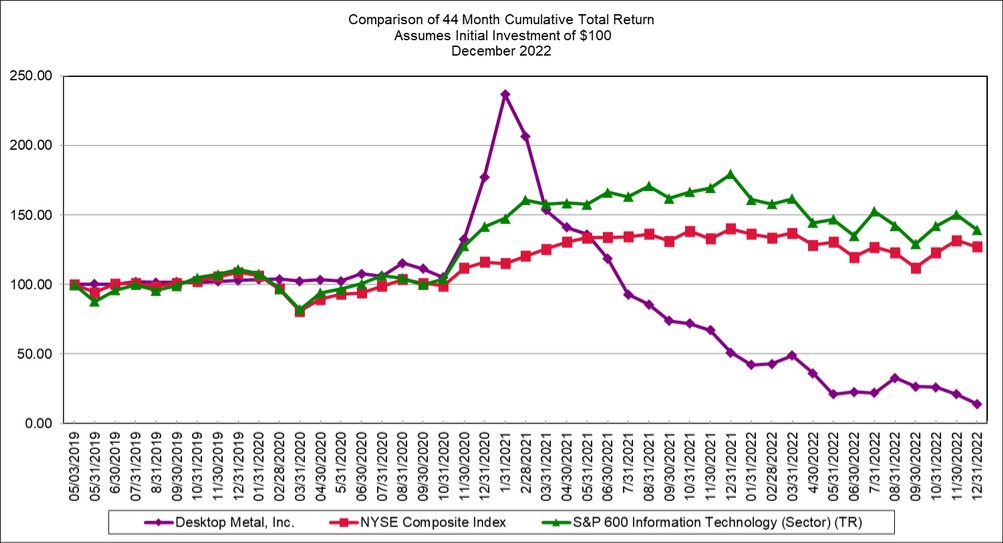BASIS OF PRESENTATION
On December 9, 2020, we consummated the business combination, or the Business Combination, contemplated by the Agreement and Plan of Merger, dated August 26, 2020, by and among our company (formerly known as Trine Acquisition Corp.), Desktop Metal Operating, Inc. (formerly known as Desktop Metal, Inc.) and Sparrow Merger Sub, Inc., pursuant to which Sparrow Merger Sub, Inc. merged with and into Desktop Metal Operating, Inc., with Desktop Metal Operating, Inc. becoming our wholly owned subsidiary. Upon the closing of the Business Combination, we changed our name to Desktop Metal, Inc.
Unless otherwise indicated or the context otherwise requires, references in this Annual Report on Form 10-K to “we,” “us,” “the company” and “Desktop Metal” refer to the consolidated operations of Desktop Metal, Inc. and its subsidiaries. References to “Trine” refer to the company prior to the consummation of the Business Combination and references to “Legacy Desktop Metal” refer to Desktop Metal Operating, Inc. prior to the consummation of the Business Combination.
CAUTIONARY NOTE REGARDING FORWARD-LOOKING STATEMENTS
This Annual Report on Form 10-K, including "Management’s Discussion and Analysis of Financial Condition and Results of Operations" in Item 7, contains forward-looking statements. All statements contained in this Annual Report on Form 10-K other than statements of historical fact, including statements regarding our future operating results and financial position, our business strategy and plans, market growth, trends, events, and our objectives for future operations, are forward-looking statements. The words “may,” “will,” “expect,” “anticipate,” “believe,” “intend,” “project,” “could,” “would,” “estimate,” “potential,” “continue,” “plan,” “target,” or the negative of these words or similar expressions are intended to identify forward-looking statements.
The forward-looking statements included herein are based on current expectations of management. Actual results may differ from those expressed in forward-looking statements due to additional factors, including those set forth in Part I, Item 1A. “Risk Factors” elsewhere in this Annual Report on Form 10-K. Although we believe that expectations reflected in the forward-looking statements are reasonable, we cannot guarantee future results, performance, or achievements. The events and circumstances reflected in our forward-looking statements may not be achieved or occur, and actual results could differ materially from those projected in the forward-looking statements. Moreover, we operate in an evolving environment. New risk factors and uncertainties may emerge from time to time, and it is not possible for management to predict all risk factors and uncertainties. As a result of these factors, we cannot assure you that the forward-looking statements in this Annual Report on Form 10-K will prove to be accurate. Except as required by applicable law, we do not plan to publicly update or revise any forward-looking statements contained herein, whether as a result of any new information, future events, changed circumstances, or otherwise.
You should read this Annual Report on Form 10-K completely and with the understanding that our actual future results may be materially different from what we expect. We qualify all of our forward-looking statements by these cautionary statements.
PART I
Item 1. Business
Business Overview
Desktop Metal is pioneering a new generation of additive manufacturing technologies focused on Additive Manufacturing 2.0, the volume production of end-use parts. We offer a comprehensive portfolio of integrated additive manufacturing solutions comprised of hardware, software, materials and services with support for metals, polymers, elastomers, ceramics, sands, composites, wood and biocompatible materials. Our solutions span use cases across the product life cycle, from product development to mass production and aftermarket operations, and they address an array of industries, including automotive, healthcare and dental, consumer products, heavy industry, aerospace, machine design and research and development.
At Desktop Metal, we believe additive manufacturing, commonly referred to as 3D printing, is one of the most exciting and transformational technology innovations of our time. According to market research and management estimates, the global additive manufacturing market, which includes spending on systems, materials, parts and other 3D printing software and services, is expected to grow from $15.2 billion in 2021 to approximately $100.0 billion by 2031 at a compound annual growth rate of approximately 20%.
